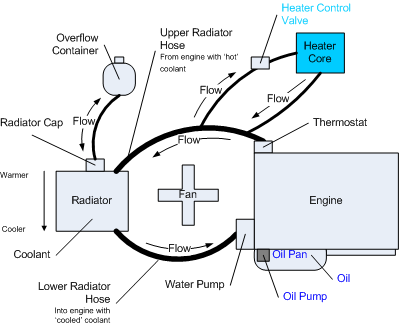
This section contains high level explanations of the components that comprised the cooling system.

| Component | Definition |
|---|---|
| Coolant | A.K.A. Radiator fluid, antifreeze. A poisonous liquid comprised of distilled water and chemicals to raise its boiling point and resists freezing. In cold weather, the mixture is 70% coolant to water, and in warmer weather, the mixture is usually 50%. |
| Radiator Cap | A spring loaded cap that allows excess pressurized coolant to leave the cooling system into the Overflow Container. But, when the cooling systems cools, it allows the overflowed coolant to be brought back into the system. This feature helps keep your radiator at the proper coolant level. |
| Radiator | Is a heat exchanger used to transfer the heat from the coolant running through it on the inside to the outside atmospheric air. This effect removes some heat from the coolant allowing it to re-enter the engine block to help extract additional heat. |
| Overflow Container | A.K.A Coolant Reservoir. This container holds extra coolant. As the coolant in the cooling system expands, the extra coolant is diverted into this reservoir via the radiator cap. As the cooling system cools, the cooling system pulls back this coolant. This feature allow the cooling system to always have the optimal coolant level. |
| Upper Radiator Hose | In most systems, the upper radiator hose is used to transfer the warmest coolant in the system to the upper radiator to be cooled before it is returned to the engine block. |
| Lower Radiator Hose | In most system, the lower radiator hose is used to transfer the coolest coolant in the system to the engine block. |
| Fan | This fan can either be rotated via the crank or an electric motor. In either case, it pulls cooler air through the radiator and pushes air over the engine block in an effort to assist in cooling the engine when automobile isn’t in motion. |
| Water Pump | The water pump can either be driven via a crank driven belt or a crank driven timing belt. The purpose of this pump is to push coolant through the engine block into the radiator. I have seen some racing applications where the water pump is driven by an electric motor. |
| Thermostat | The thermostat is usually located on the top of the engine block, allowing or preventing coolant from flowing into the upper radiator hose. In most applications, the thermostat will be closed when the coolant temperature is below 190 degrees. By doing this, it allows the engine block to warm up quicker. |
| Heater Control Valve | This valve is either controlled mechanically, via vacuum, or electrically. This valve can either allow warm engine coolant to flow through the heater core or prevent it from flowing through the heater core. |
| Heater Core | The heater core is a radiator located in the driver compartment which is used to warm air. A blower in the driver compartment moves air through this radiator, which contains warm coolant from the engine. This warms up the air. This warmed air is then directed into the driver compartment via air ducts and vents. |
| Oil Pan | A.K.A Oil Reservoir. The oil pan holds all the oil that isn’t in the engine block. At the bottom of the oil pan is where the oil drain plug is located. |
| Oil | Oil acts as a lubricant and a way to pull heat from the motor. It contains additives that help it maintain a certain viscosity, lubricate metal to metal contact, pull heat from engine, … |
| Oil Pump | Usually, the oil pump is driven by the crankshaft. It pushes cooler coil, from the bottom of the oil pan, up through the engine block. The block is comprised of numerous oil passages to allow the oil to reach all the engine components requiring lubrication. |
| Engine | The internal combustion engine is what this web site is all about. Who knows how long these types of engines will be used? Until then, this web site will try to supply you information and resources to allow you to be a successful DIYer. |